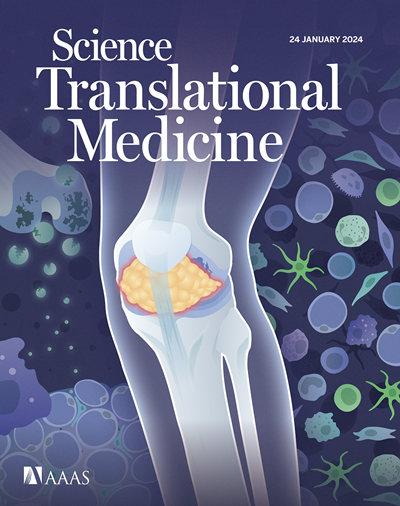针对 SARS-CoV-2 的多特异性抗体可防止体外免疫逃逸,并在体内提供预防性保护。
IF 15.8
1区 医学
Q1 CELL BIOLOGY
引用次数: 0
摘要
尽管采取了有效的应对措施,但严重急性呼吸系统综合症冠状病毒 2(SARS-CoV-2)仍在全球范围内持续存在,因为它具有多样化和逃避人类免疫的能力。这种逃避能力源于氨基酸的置换,尤其是尖峰蛋白的受体结合域(RBD),该受体结合域对疫苗诱导的抗体和抗体疗法具有抗性。为了限制病毒通过抗性突变逃逸,我们将识别不同 RBD 位点的抗体可变区组合成多特异性抗体。在这里,我们描述了多特异性抗体,包括一种三价三特异性抗体,它能有效中和多种 SARS-CoV-2 变体,并比单一抗体或亲代抗体的混合物更有效地防止病毒逃逸。尽管这种三特异性抗体是在 Omicron 出现之前产生的,但在纳摩尔浓度下,它能中和从 BA.4/BA.5 到 Omicron 的所有主要变体。负染色电子显微镜表明,协同中和是通过不同表位的特异取向结合实现的,这种结合有利于跨越多个尖峰蛋白。此外,含有与三价三特异性抗体相同可变区的四价三特异性抗体也能保护叙利亚仓鼠免受奥米克龙变体 BA.1、BA.2 和 BA.5 的挑战,每种变体都使用不同的氨基酸取代来介导治疗性抗体的逃避。这些结果表明,多特异性抗体有可能提供广泛的SARS-CoV-2覆盖范围,降低逃逸的可能性,简化治疗,并为抗体疗法提供一种策略,有助于消除这种病原体和其他病原体的大流行。本文章由计算机程序翻译,如有差异,请以英文原文为准。
A multispecific antibody against SARS-CoV-2 prevents immune escape in vitro and confers prophylactic protection in vivo
Despite effective countermeasures, severe acute respiratory syndrome coronavirus 2 (SARS-CoV-2) persists worldwide because of its ability to diversify and evade human immunity. This evasion stems from amino acid substitutions, particularly in the receptor binding domain (RBD) of the spike protein that confers resistance to vaccine-induced antibodies and antibody therapeutics. To constrain viral escape through resistance mutations, we combined antibody variable regions that recognize different RBD sites into multispecific antibodies. Here, we describe multispecific antibodies, including a trivalent trispecific antibody that potently neutralized diverse SARS-CoV-2 variants and prevented virus escape more effectively than single antibodies or mixtures of the parental antibodies. Despite being generated before the appearance of Omicron, this trispecific antibody neutralized all major Omicron variants through BA.4/BA.5 at nanomolar concentrations. Negative stain electron microscopy suggested that synergistic neutralization was achieved by engaging different epitopes in specific orientations that facilitated binding across more than one spike protein. Moreover, a tetravalent trispecific antibody containing the same variable regions as the trivalent trispecific antibody also protected Syrian hamsters against Omicron variants BA.1, BA.2, and BA.5 challenge, each of which uses different amino acid substitutions to mediate escape from therapeutic antibodies. These results demonstrated that multispecific antibodies have the potential to provide broad SARS-CoV-2 coverage, decrease the likelihood of escape, simplify treatment, and provide a strategy for antibody therapies that could help eliminate pandemic spread for this and other pathogens.
求助全文
通过发布文献求助,成功后即可免费获取论文全文。
去求助
来源期刊

Science Translational Medicine
CELL BIOLOGY-MEDICINE, RESEARCH & EXPERIMENTAL
CiteScore
26.70
自引率
1.20%
发文量
309
审稿时长
1.7 months
期刊介绍:
Science Translational Medicine is an online journal that focuses on publishing research at the intersection of science, engineering, and medicine. The goal of the journal is to promote human health by providing a platform for researchers from various disciplines to communicate their latest advancements in biomedical, translational, and clinical research.
The journal aims to address the slow translation of scientific knowledge into effective treatments and health measures. It publishes articles that fill the knowledge gaps between preclinical research and medical applications, with a focus on accelerating the translation of knowledge into new ways of preventing, diagnosing, and treating human diseases.
The scope of Science Translational Medicine includes various areas such as cardiovascular disease, immunology/vaccines, metabolism/diabetes/obesity, neuroscience/neurology/psychiatry, cancer, infectious diseases, policy, behavior, bioengineering, chemical genomics/drug discovery, imaging, applied physical sciences, medical nanotechnology, drug delivery, biomarkers, gene therapy/regenerative medicine, toxicology and pharmacokinetics, data mining, cell culture, animal and human studies, medical informatics, and other interdisciplinary approaches to medicine.
The target audience of the journal includes researchers and management in academia, government, and the biotechnology and pharmaceutical industries. It is also relevant to physician scientists, regulators, policy makers, investors, business developers, and funding agencies.
 求助内容:
求助内容: 应助结果提醒方式:
应助结果提醒方式:


